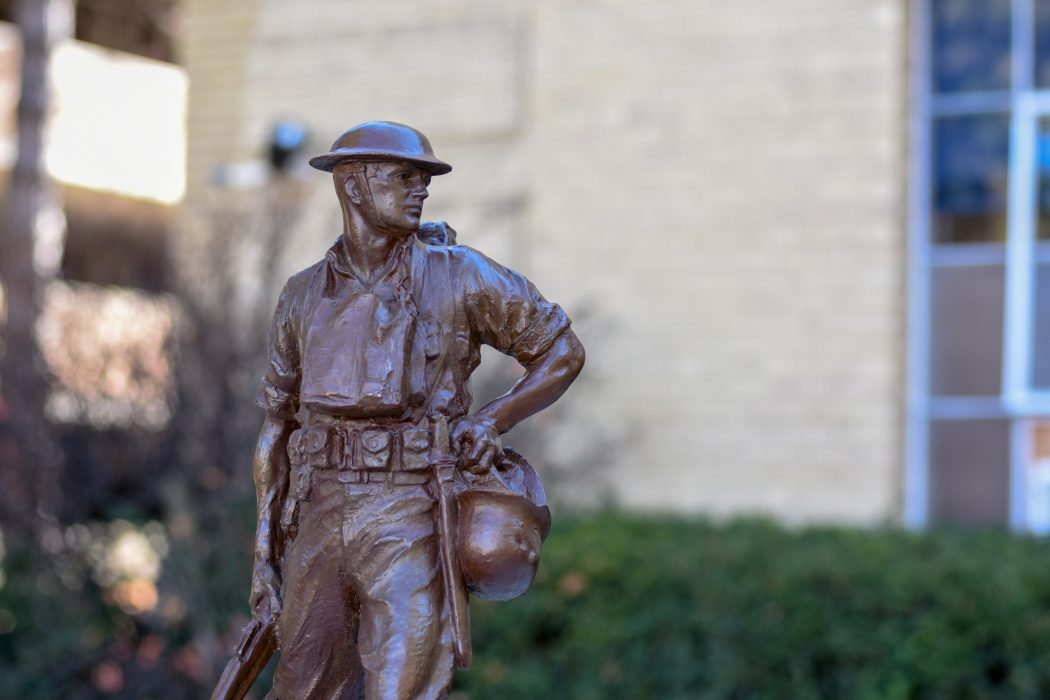Student and faculty commemorate WWI centennial
In honor of the 100-year anniversary of the end of World War I, professors and students throughout Utah State University held events that examined the influence of the war on USU and the world through art and artifacts from the era.
Projects in honor of the WW1 centennial reached almost every department on campus, ranging from events like a concert attempting to approximate veterans experiences, to a discussion of the mathematics of preventing disease, to displays of nursing posters and other contemporary art.
“A lot of us who were working independently on projects came together and began to unify those projects under one umbrella under a series of events that were interrelated,” said Evelyn Funda, the associate dean of the College of Humanities and Social Sciences.
The events showcased multiple facets of the war. Funda said that the end of the war on November 11, 1918, was marked by celebration and relief, but also a gaping loss and a search for meaning in the wake of the deadliest war in history to that point. Survivors and witnesses to the conflict turned to poetry, music, and art as expressions of the grief and terror of the war.
“It’s not just an important historical event, but it’s also a kind of cultural sea change,” she said. “As a culture, we were kind of lost after World War I. It’s a profoundly important moment globally, not just in U.S. culture, in how we see ourselves as human beings, involved with each other, with other nations, as a global power.”
Funda, who is co-teaching a course on the events of 1918 this semester with Susan Grayzel, worked with students to develop a poetry reading and antique roadshow for the centennial.
“With the trench poetry, they went from the ground up, they made the decisions, they rehearsed, they decided what to read, it was all them,” Funda said.
Events like the roadshow as well as displays in the anthropology and nursing schools focused on the physical remains from the war. The Museum of Anthropology on campus is currently displaying outfits worn by pilots in the war, curated by USU students in 2014 to mark the start of the war.
Molly Cannon, the executive director of the Museum of Anthropology, said the materials of World War I were instrumental in forming the modern understanding of the war, offering unique insight and context for a dramatically new kind of military conflict.
“We have material culture, we’re a museum, so that’s part of what we do, we preserve the culture,” Cannon said. “With the pilots, you can go and see what they would have had on them when they were in these airplanes, the objects that helped them with their daily tasks.”
History Professor Emily Wheeler has focused on the cultural impact of World War I on USU, then known as the Utah Agricultural College. Wheeler said the war contributed to the growth of USU and Cache Valley.
“The campus as we know it today, its growth really started at that time,” she said. “It did a lot to kind of bring — not just Cache Valley or just the college, but Utah in general in step with the rest of the country. It kind of gave a chance for Utah to cement its place in the country.”
Wheeler explained how former USU President E.G. Peterson built Ray B. West and other buildings around the Quad as barracks for soldiers due to declining enrollment during the war. Years later, USU became known as the “West Point of the West.”
The library also set up “USU at War,” a display of photos and newspaper clippings from the era. The display covered all years of the war but also included a local paper’s announcement of the armistice.
“I wanted to display materials that could connect with the students,” said Clint Humphrey, who helped organize the display. “I think sometimes when you’re commemorating the 100-year anniversary of something, it’s really hard to forge a connection with something that happened that long ago, so when we were choosing the materials I wanted to find images that were of students.”
The common thread between all the events was the emphasis on the lessons learned through the conflict.
“I think it’s good to remember that sacrifices that might not seem as big to us still had a huge impact at the time and that we shouldn’t forget the things that got us to today,” Wheeler said.
“We have a responsibility to learn from history, by studying history and observing the past, there are lessons there to be learned and applied in issues and challenges we face today,” Cannon said.
—mwcrabtr@gmail.com
@bread_dish

